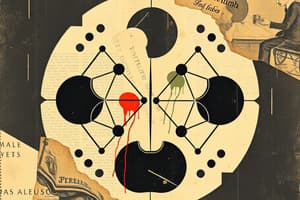Podcast
Questions and Answers
During which phase of the cell cycle does DNA replication primarily occur?
During which phase of the cell cycle does DNA replication primarily occur?
- G1 phase
- Mitosis
- S phase (correct)
- G2 phase
If a cell is in a 'resting' state without active cell division, it is considered to be in which phase?
If a cell is in a 'resting' state without active cell division, it is considered to be in which phase?
- G1 phase
- Mitosis
- G0 phase (correct)
- S phase
Sister chromatids separate during which phase of mitosis?
Sister chromatids separate during which phase of mitosis?
- Prophase
- Telophase
- Anaphase (correct)
- Metaphase
What cellular process begins during anaphase and continues through telophase, ultimately dividing the cytoplasm?
What cellular process begins during anaphase and continues through telophase, ultimately dividing the cytoplasm?
Malignant cells often bypass normal regulatory mechanisms, leading to:
Malignant cells often bypass normal regulatory mechanisms, leading to:
What term describes the process by which malignant cells spread to other tissues and organs?
What term describes the process by which malignant cells spread to other tissues and organs?
Which of the following proteins plays a critical role in suppressing tumor formation?
Which of the following proteins plays a critical role in suppressing tumor formation?
What structures, shortened with each cell division, are implicated in cellular aging?
What structures, shortened with each cell division, are implicated in cellular aging?
Chemotherapy's side effects often target rapidly dividing cells. Which of the following normal tissues is most susceptible?
Chemotherapy's side effects often target rapidly dividing cells. Which of the following normal tissues is most susceptible?
What is an important consideration when providing anesthetic care to an immunosuppressed patient undergoing cancer treatment?
What is an important consideration when providing anesthetic care to an immunosuppressed patient undergoing cancer treatment?
Which phase of the cell cycle is primarily targeted by alkylating agents?
Which phase of the cell cycle is primarily targeted by alkylating agents?
Pulmonary fibrosis and pneumonitis are associated with which class of chemotherapeutic agents?
Pulmonary fibrosis and pneumonitis are associated with which class of chemotherapeutic agents?
Platinum complexes, such as cisplatin, work by:
Platinum complexes, such as cisplatin, work by:
Which of the following is a common side effect associated with cisplatin, similar to the effects of loop diuretics?
Which of the following is a common side effect associated with cisplatin, similar to the effects of loop diuretics?
Antimetabolites exert their cytotoxic effects by mimicking:
Antimetabolites exert their cytotoxic effects by mimicking:
Which of the following is a common dermatologic side effect associated with antimetabolite drugs?
Which of the following is a common dermatologic side effect associated with antimetabolite drugs?
Topoisomerase inhibitors lead to DNA breakage by inhibiting:
Topoisomerase inhibitors lead to DNA breakage by inhibiting:
What heart condition is a known risk associated with antitumor antibiotics like daunorubicin?
What heart condition is a known risk associated with antitumor antibiotics like daunorubicin?
Bleomycin is a chemotherapy drug known to cause:
Bleomycin is a chemotherapy drug known to cause:
Which perioperative anesthetic consideration is important for patients taking bleomycin?
Which perioperative anesthetic consideration is important for patients taking bleomycin?
Flashcards
Cell cycle phases
Cell cycle phases
G1, S, G2, and Mitosis
What is the G0 phase?
What is the G0 phase?
A “resting” cell phase with no cellular division.
Prophase
Prophase
Chromatin condenses into chromosomes, nuclear envelope breaks down, spindle fibers form.
Metaphase
Metaphase
Signup and view all the flashcards
Anaphase
Anaphase
Signup and view all the flashcards
Telophase
Telophase
Signup and view all the flashcards
Cytokinesis
Cytokinesis
Signup and view all the flashcards
True or False: Malignant cells
True or False: Malignant cells
Signup and view all the flashcards
Metastasis
Metastasis
Signup and view all the flashcards
Important tumor suppressor?
Important tumor suppressor?
Signup and view all the flashcards
Telomeres
Telomeres
Signup and view all the flashcards
True or False: Chemo toxicity
True or False: Chemo toxicity
Signup and view all the flashcards
Bleomycin's pulmonary effect
Bleomycin's pulmonary effect
Signup and view all the flashcards
Bleomycin anesthetic risks
Bleomycin anesthetic risks
Signup and view all the flashcards
Cell cycle of Microtubule inhibitors?
Cell cycle of Microtubule inhibitors?
Signup and view all the flashcards
Classes of microtubule inhibitors
Classes of microtubule inhibitors
Signup and view all the flashcards
SE of microtubule inhibitors
SE of microtubule inhibitors
Signup and view all the flashcards
Target of signal transduction modifiers
Target of signal transduction modifiers
Signup and view all the flashcards
Treated autoimmune diseases
Treated autoimmune diseases
Signup and view all the flashcards
Hormones with increased thromboembolic risk
Hormones with increased thromboembolic risk
Signup and view all the flashcards
Study Notes
- The four major phases of the cell cycle are G1, S, G2, and Mitosis.
- The resting phase with no cellular division is G0.
Mitosis Phases
- Prophase involves chromatin condensing into distinct chromosomes, migrating to the cell center. The nuclear envelope breaks down, and spindle fibers form.
- Metaphase is characterized by the disappearance of the nuclear membrane, development of the spindle, and alignment of chromosomes.
- Anaphase entails the separation of paired chromosomes (sister chromatids) and the lengthening of spindle fibers.
- Telophase sees chromosomes sectioned off into two distinct new nuclei with equal genetic content, with cytokinesis (division of the cytoplasm) beginning after anaphase and finishing after telophase to form two new cells.
- Malignant cells escape normal mechanisms controlling cellular division and growth
- Metastasis is the migration and invasion of malignant cells into other tissues
- P53 is an important tumor suppressor
DNA and Chemotherapy
- Telomeres are the DNA "end caps" linked to cellular aging.
- Chemotherapy toxicity side effects often relate to rapidly dividing cell targets like hair follicles and mucosal cells
- Aseptic methods and prophylactic antibiotics are anesthetic considerations for immunosuppressed cancer patients
Alkylating Agents
- Work is not done in any specific cell-cycle phase
- Pulmonary side effects include pneumonitis, fibrosis, and decreased diffusion capacity
- They inhibit the activity of plasma cholinesterase, affecting anesthetic drugs
- Cardiotoxicity is an additional side effect
- Cyclophosphamide is a specific example
Platinum Complexes
- Affect solid tumors and are not cell-cycle specific
- They cross-link DNA, disrupting its replication and division in an alkylating-like effect
- Cisplatin side effects resemble those of loop diuretics and aminoglycosides: nephrotoxicity and ototoxicity
- Other side effects include peripheral neuropathy, nausea and vomiting, myelosuppression, and hypersensitivity reactions
Antimetabolites
- These mimic cellular nutrients like folic acid and inhibit enzymes like nucleobases, working primarily in the S phase
- Dermatologic side effects include dermatitis, pigmentation changes, nail changes, alopecia, and photosensitivity
Other Toxicities
- Significant GI toxicity (stomatitis, ulceration, diarrhea, hemorrhagic enteritis, perforation) is a notable side effect along with nephrotoxicity, hepatotoxicity, and CNS effects
Topoisomerase Inhibitors
- Inhibit topoisomerase enzymes during the S and early G2 phases, leading to DNA breakage
- Cardiotoxicity is a heart condition commonly caused by antitumor antibiotics like daunorubicin
- Free radicals disrupt cardiac proteins and cell membrane components, causing cardiotoxicity
Bleomycin
- Causes pulmonary toxicity
- Anesthetic considerations minimize crystalloids, consider colloids, and keep FiO2 low (below 30% if possible)
- Excessive crystalloid administration and hyperoxia during anesthesia increase the risk of pulmonary toxicity
Microtubule Inhibitors
- Are active in the M phase
- Two main drug classes: Vinca Alkaloids and Taxanes
- Neuromuscular side effects include sensory-motor neuropathy, areflexia, paresthesia’s, skeletal weakness, skeletal muscle pain, and ataxia.
- Dexamethasone is provided for edema and effusion, and Sigamedex is given instead of Neostigmine for residual musculoskeletal blockade
- Regional anesthesia may worsen neuropathy
Signal Transduction Modifiers
- Disrupt growth factor-receptor interactions or target overexpressed antigens
- Monoclonal antibodies target autoimmune diseases and cancer antigens or receptors.
- Monoclonal antibodies also treat multiple sclerosis and rheumatoid arthritis
- Anti-estrogens like Tamoxifen can increase the risk of thromboembolic events and stroke (boxed warning)
- Vaccines are administered in cancer or at-risk populations to decrease the risk of developing cancer
Memory Master Points
- Bleomycin is toxic to the pulmonary organ, causing endothelial and epithelial damage via free radical production in the presence of oxygen and iron/copper, leading to pulmonary fibrosis
- O2 concentration for patients taking bleomycin should be above 90 but below 100 (lower inhaled oxygen concentrations below 30%) to avoid exacerbating lung damage, while maintaining O2 saturation above 90%
- Cisplatin toxicity includes nephrotoxicity, peripheral neuropathy, marked nausea and vomiting (black box warning), hypersensitivity reaction, myelosuppression, and ototoxicity
- Doxorubicin is toxic to the heart (cardiotoxicity) and can cause dose-related cardiomyopathy and arrhythmias from free radical formation disrupting cardiac proteins and cell membranes.
Studying That Suits You
Use AI to generate personalized quizzes and flashcards to suit your learning preferences.




